Explore New Mail Features
Like most things in Ventura, Mail looks almost indistinguishable from the Monterey version at first glance. There are several important new features, but although they’re rather subtle at first, I expect you’ll soon find them indispensable.
Use Smart Search
Over many versions of Apple Mail, I’ve been perturbed at the slow, unreliable, and inconsistent search feature. So when I saw something called “smart search,” I assumed this meant Apple had finally fixed searching and made it, you know, smart, as in intelligently returning the results I was looking for. Reader, I was mistaken. The many routine searches I’ve performed in Mail for Ventura have been no more accurate or reliable than those in Monterey. And smart search—although it may indeed be valuable in some cases—doesn’t address the problems most people have experienced.
Rather, smart search consists of two elements:
Corrections: If you misspell a word when typing in the Search field, Mail now searches for the term as if you had spelled it correctly. Similarly, Mail now searches for synonyms or similar words to the word you type. Search for
cofeeeand Mail shows you matches for coffee; search forfinancesand Mail shows you matches that include financial. This feature works only in English, and in my testing, has been sort of hit-and-miss.Search suggestions: As you start typing in the Search field, Mail suggests terms that might match what you’re looking for, which may include phrases, contacts, names of attachments, and more. For example, type
appleand a menu may pop up under the Search field with options like Apple Support, Johnny Appleseed, apple id, and Attachment name contains: apple.
Undo Sending an Email Message
Sender’s remorse is an odd phenomenon that occurs, reliably, just seconds after you send an email message. For some reason, clicking that Send button seems to trigger your brain to realize you sent the message to the wrong person, or forgot to say something important, or were hasty or unkind in your wording. Now, at last, Mail offers a way to exploit that brief “Oops!” window to undo sending the message. (Messages now has a similar feature; see Edit or Unsend a Message.)
Once an email message has left your device, it can’t be unsent anymore than a bell can be unrung. So this feature works by delaying the sending of every message by 10 seconds. Whenever you click the Send ![]() icon (or choose Message > Send or press ⌘-Shift-D), Mail queues up the message but, by default, doesn’t deliver it for 10 seconds. During that time, if you decide to take it back, choose Edit > Undo Send, press ⌘-Z, or click Undo Send at the bottom of Mail’s sidebar. The unsent draft then opens in its own window, where you can edit it or ditch it altogether.
icon (or choose Message > Send or press ⌘-Shift-D), Mail queues up the message but, by default, doesn’t deliver it for 10 seconds. During that time, if you decide to take it back, choose Edit > Undo Send, press ⌘-Z, or click Undo Send at the bottom of Mail’s sidebar. The unsent draft then opens in its own window, where you can edit it or ditch it altogether.
If you need more time to decide whether to unsend a message, go to Mail > Settings > Composing and choose 20 Seconds or 30 Seconds from the “Undo send delay” pop-up menu, rather than the default of 10 Seconds. On the other hand, if it’s more important to you that your messages be delivered immediately than to be able to undo sending them, choose Off.
Schedule Sending a Message
Sometimes I compose a message late at night but I prefer to send it during work hours when the recipient is more likely to see it right away. Other times I may want to send something like an announcement or newsletter on a specific day in the future, but not leave it hanging around in my Drafts mailbox until then. For reasons like these, Mail now lets you schedule outgoing messages instead of sending them immediately.
To do this, compose and address your message as usual. Then, instead of clicking the Send ![]() icon (or choosing Message > Send or pressing ⌘-Shift-D), click the small, unlabeled
icon (or choosing Message > Send or pressing ⌘-Shift-D), click the small, unlabeled ![]() pop-up menu to the right of the Send
pop-up menu to the right of the Send ![]() icon and choose Send at 9:00 PM Tonight, Send 8:00 AM Tomorrow, or Send Later. If you choose Send Later, use the dialog that appears (Figure 21) to select a date and time, and click Schedule.
icon and choose Send at 9:00 PM Tonight, Send 8:00 AM Tomorrow, or Send Later. If you choose Send Later, use the dialog that appears (Figure 21) to select a date and time, and click Schedule.
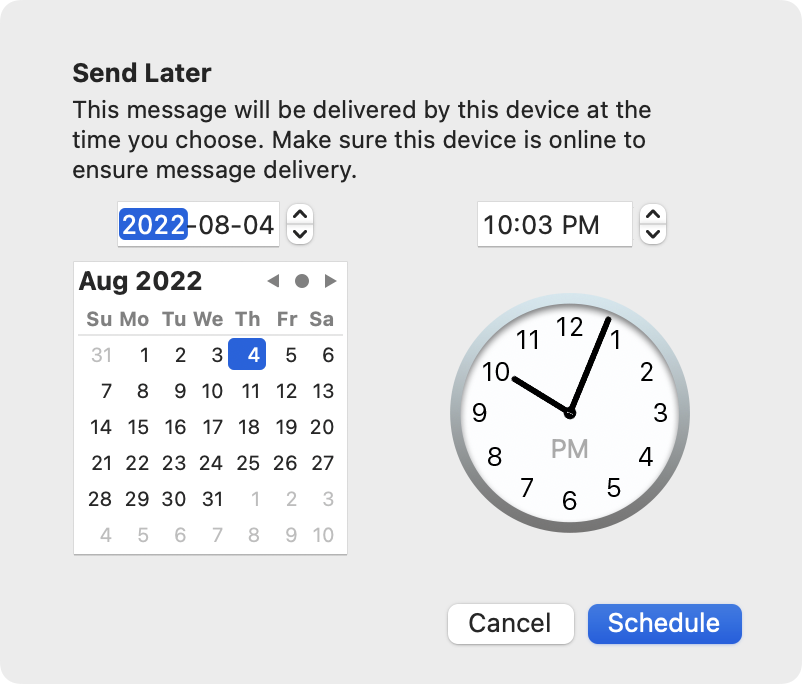
When the appointed time comes, Mail sends your message…but your Mac must be on and awake at that time, and Mail must be open. If any of those conditions aren’t met (or if your Mac doesn’t have an internet connection at that moment), your message will not send until they are. I want to call extra attention to this fact, because you may be accustomed to scheduling events to occur using websites or cloud services that function independently of your Mac, but this feature isn’t like that.
Follow Up on Messages Awaiting Replies
I frequently send other people messages expecting replies and then, days or weeks later, realize I never heard back from them. Maybe my message was swallowed by a spam filter or lost in an overflowing inbox, or maybe the other person just got busy or forgot. Mail has a new Follow Up feature that keeps track of messages you’ve sent that haven’t received replies, and asks if you want to follow up.
This feature is enabled by default, but you can turn it on or off by going to Mail > Settings > General and toggling the “Enable message follow up suggestions” checkbox.
When the feature is enabled, Mail waits three days after you send a message to see if the recipient replies. If not, the message (still in your Sent mailbox) also appears at the top of your inbox (if View > Sort By is set to Newest Message on Top) or the bottom (if View > Sort By is set to Oldest Message on Top), with a banner at the top (Figure 22) that reminds you when you sent the message. Click Follow Up to compose your message (quoting the original for context).

Remind Yourself About Important Messages
I am one of those obnoxious, excessively organized Inbox Zero people. I’m not saying my inbox is always empty, or even empty at the end of every single day, but I habitually deal with email as quickly as I can, and I don’t use my inbox as a to-do list. Once I’ve handled a message in whatever fashion is appropriate, I file it (or, occasionally, delete it). It is rare for my inbox to contain even ten messages for more than a few hours. My point is: I never forget about messages in my inbox, because they are never there long enough to be forgotten.
Not everyone is exactly like me (and thank goodness). I know people who have tens of thousands of messages in their inboxes. Maybe more. And if you’re one of those people who permits messages to accumulate in your inbox—even if just a few dozen—you might easily forget that some message requires a reply by a certain date, or that you promised to follow up with a particular sender. Mail can help you in situations like this, with a feature called Remind Me.
I want to emphasize that this feature is only for messages in your inbox. You can’t ask for a reminder about messages you’ve already filed elsewhere, and if you do ask for a reminder but then file the message before the reminder time comes around, Mail does nothing.
Here’s how to use this feature:
Select a message in your inbox.
Go to Message > Remind Me (or Control-click/right-click the message and go to the Remind Me submenu of the contextual menu) and choose Remind Me in 1 Hour, Remind Me Tonight, Remind Me Tomorrow, or Remind Me Later. With that last choice, a dialog (Figure 23) pops up where you can set the exact time and date of your reminder; click Schedule when you’re done.
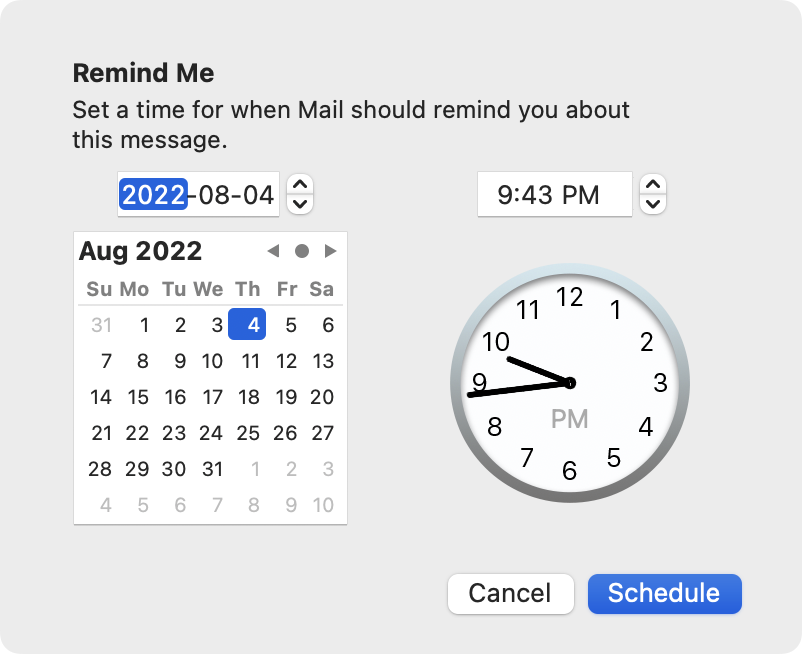
Mail puts a reminder ![]() badge on the message preview in the message list, as well as a banner at the top of the message (Figure 24) with an Edit button you can use to change the reminder time. Mail also displays the message in a temporary Remind Me smart mailbox that appears under Favorites in Mail’s sidebar.
badge on the message preview in the message list, as well as a banner at the top of the message (Figure 24) with an Edit button you can use to change the reminder time. Mail also displays the message in a temporary Remind Me smart mailbox that appears under Favorites in Mail’s sidebar.

When the time and date you’ve set arrives, the message bubbles up to the very top of your inbox (if View > Sort By is set to Newest Message on Top) or drops to the bottom (if View > Sort By is set to Oldest Message on Top). If you have notifications turned off for Mail (a sensible thing to do so that you don’t see and hear an alert every time you get a new messages), then the reordering of that message in your inbox is the only reminder you get.
Get Notifications for Missing Attachments and Recipients
We’ve all done it: sent an email that was supposed to include an attachment but didn’t. Mail now helps you to prevent this. When you send a message, Mail first checks to see if the text contains any words or phrases that suggest it was intended to include an attachment (such as, “See attached file” or “I’ve enclosed the document”). If the message does contain such text—but there’s no attachment—Mail warns you (Figure 25). You can then click Cancel and add the attachment, or click Send Anyway to send the message as is.
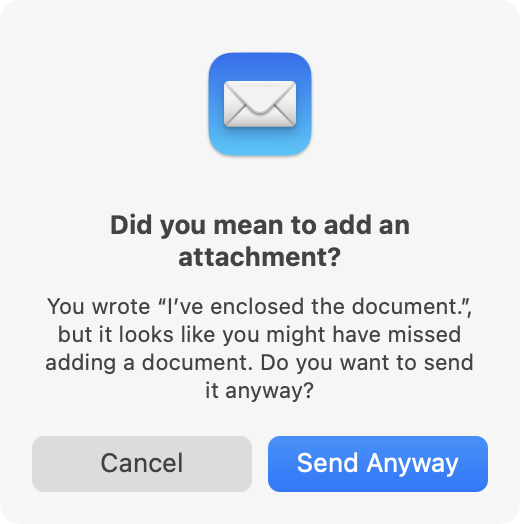
Similarly, Mail looks for signs that you may have intended to include other recipients for the message (such as “I’m copying Glenn on this email”) and displays an appropriate alert (Figure 26). Click Add Recipient and correct the issue, click Cancel to make other changes, or click Send Anyway.
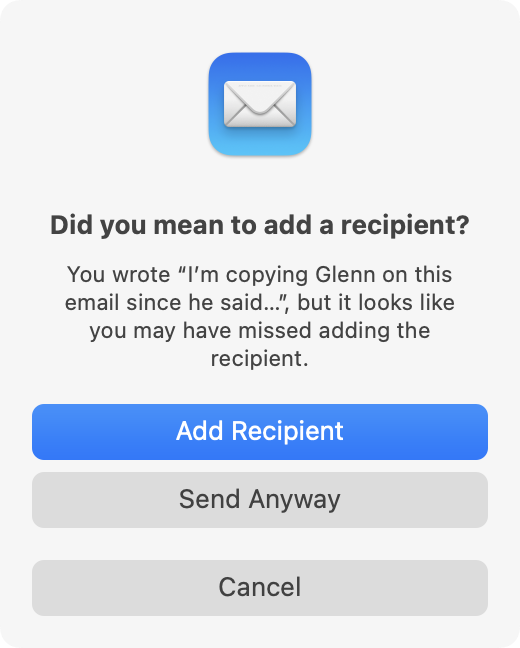
Compose Messages with Rich Links
When you email someone a web link, normally it appears as blue, underlined text. If you’d prefer your recipient to have a clearer idea of what they’ll get if they click the link, you now can. Sometimes these rich links show just a website name and icon; other times they include a photo or other graphic (see Figure 27).
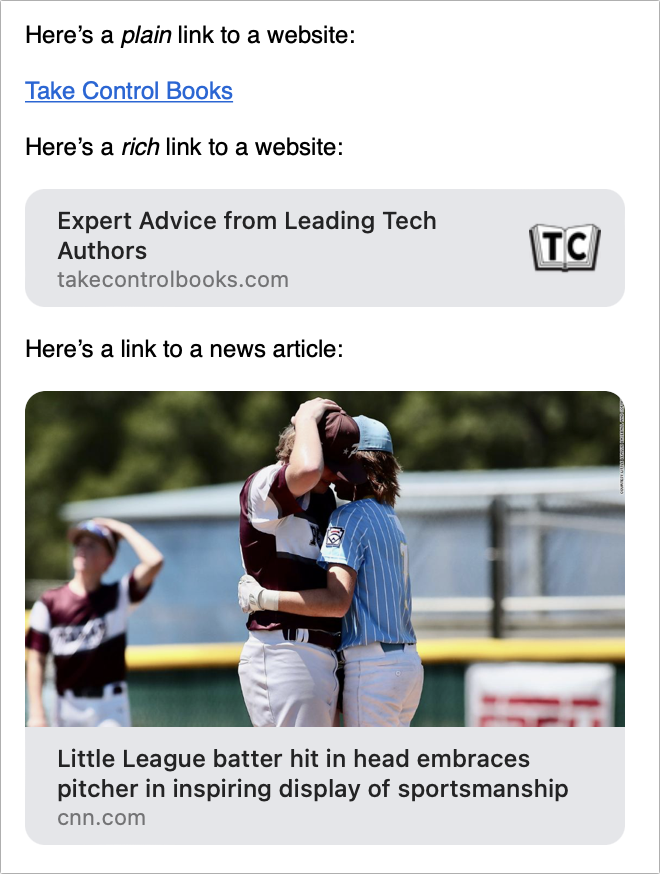
These rich links should appear automatically when you paste a link—though not when you type it—and the behavior may not be entirely consistent. (Rich links, by the way, require that the message be in Rich Text format; if you’re composing a plain text message and want to see rich links and other formatting, choose Format > Make Rich Text.)
If you have a plain link in your message—whether it looks like a raw URL or like a blue, underlined page title—and you want to turn it into a rich link, hover over it, click the arrow ![]() icon that appears to its right, and choose Show Link Preview from the pop-up menu.
icon that appears to its right, and choose Show Link Preview from the pop-up menu.
Conversely, if you have a rich link and you want to show the raw URL instead, hover over it, click the arrow ![]() icon that appears just beyond its top-right corner, and choose Convert to Plain Link from the pop-up menu.
icon that appears just beyond its top-right corner, and choose Convert to Plain Link from the pop-up menu.
Check for Authenticity of Branded Messages
When you get an email message from your financial institution or another big company, how do you know it’s not fake? A mechanism intended to help people make that call is BIMI (Brand Indicators for Message Identification), which puts a verified copy of the sender’s logo in the header after confirming that the sender is legitimate. Support for BIMI is present in the Mail app in Ventura, iOS 16, and iPadOS 16.
You’ll see this logo in any spot where you would otherwise see a little circle with the sender’s initial(s), a generic “person” or “business” icon, or a photo or other avatar (for people in your Contacts who have images associated with their cards). That could be in the header portion of a message or, depending on your view, to the left of a message in message lists. (You can display these images in message lists in Mail by choosing View > Show Contact Photo.)
To confirm that the logo you’re seeing really is a verified brand identifier and not just a manually added image, look at the message header (Figure 28). If you see “Security: Digitally Certified,” it’s a BIMI logo, so you know the sender is legit. Click or tap Learn More to display information about the sender.

BIMI logos didn’t appear for me with the initial Ventura release, but started showing up only in December 2022 (with macOS 13.1, iOS 16.2, and iPadOS 16.2). Since then, I’ve seen wildly inconsistent behavior across my various Apple devices—sometimes they appear, sometimes they don’t, and sometimes they show up on one device but not others. This feels like a feature that isn’t fully baked yet.
Be that as it may, at the moment, very few companies have gone through the rather involved process of setting this system up. (Among other considerations, it requires the use of a registered trademark, and if your company doesn’t already have one, getting one can be quite an onerous and expensive undertaking.) So, while email sent by Apple is identified this way (at least when the feature is working), so far I have not seen examples from other companies. Your mileage may vary.
